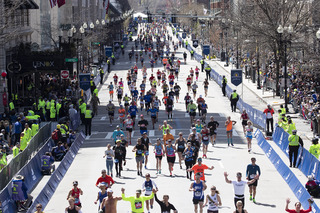Running into history Boston Marathon presented by Bank of America
31 March 2023, 7am UTC
Boston strong, 10 years after
The 127th Boston Marathon will take place on Monday 17 April. It has been 10 years since the race became the target of a domestic terrorist attack, on 15 April 2013.
That attack has been the only one of its kind to target a Marathon event. For years before it happened marathon organisers had been acutely aware of that possibility and had taken what steps they could to guard against it, but there are limitations on what measures would be practicable.
Back in 2004, in the Olympic Marathon in Athens, a spectator had run onto the course and obstructed the lead runner such that he lost about 10 seconds and dropped to third place. Although the consequences were serious only for a single runner this incident showed how a marathon event is particularly vulnerable to anyone wanting to cause disruption or damage to the participants, spectators and event itself.
After the incident race organisers sought to provide a security presence in the convoy at the head of their races aimed at protecting the leading runners. It was thought that anyone seeking to send a message would strike where the cameras were focused – at the head of the race – but this addressed the particularities of what had happened rather than the full range of possibilities through which damage could be caused.
That the terrorist attack took place at all in Boston was subject to chance. The perpetrators were two brothers, Dzhokhar and Tamerlan Tsarnaev, originally from Kirghizstan, who were self-radicalised and not connected to any terrorist groups but motivated by the wars in Afghanistan and Iraq. They had been learning to build bombs from online manuals and thought they had succeeded in doing so earlier than they expected. The ‘test event’ had been envisaged as an attack on an Independence Day (4 July) gathering in Boston but they now looked around for an earlier date. The upcoming Boston Marathon was prominent in the news and became the new target almost by default.
The aim of the attack was not specifically directed at the Boston Marathon but at the opportunity it provided. The Marathon presented a target through its ability to attract crowds to a particular location – the finish line – where injuries and deaths resulting from the bomb blasts would be at a maximum.
The Tsarnaev brothers each carried a home-made pressure-cooker bomb in their backpacks and made their way to the finish line on Boyleston Street. They stopped along the barriers at the side of the road and lowered their bags to the pavement – but left them there when they moved away. The bombs were detonated at 2:49pm, a few minutes after the brothers had left the scene. Most of the marathon field had passed through the finish, but there was a steady stream still running by when the bombs went off.
The casualties were more among the roadside spectators closest to the explosions than the runners out in the roadway. Three people died as a result of the immediate blast and there were dozens of injuries, with some estimates at over 200.
The subsequent police investigation was able to identify the bombers through surveillance cameras*. This was of great help in the manhunt that followed but cameras are not a tool that could offer any chance of preventing the bombings.
Marathons remain extremely vulnerable events to safeguard. That they have not become singled out as targets for terrorist acts is fortunate. It is perhaps partly explained by being distanced from more politically charged targets such as national rallies or important government buildings.
Earlier terrorist attacks in New York (2001), Madrid (2004) and Mumbai (2008) had all happened only a few weeks before those cities’ marathons were to take place. In all cases these marathons went ahead and proved to be cathartic as expressions of solidarity for those killed in the attacks.
“Boston Strong” is a slogan which emerged in Boston as a reaction to the marathon bombings. It focussed on the inner strength of the community rather than directing expressions of anger and revenge, much like the reaction channelled by the Marathons following the previous attacks elsewhere.
Picture credit. B.A.A
- Following the identification of the perpetrators on 18 April a manhunt quickly closed in on them. A few hours later Tamerlan, the elder of the two by seven years, died from injuries sustained in a roadside shootout. Dzhokhar escaped in a car they had earlier stolen but in doing so drove over his brother’s body. Next evening he was captured hiding under the tarpaulin of a sailboat in a back yard. He was tried and sentenced to death in 2015. The verdict was contested but confirmed by the Supreme Court in March 2023. He remains incarcerated.
See the latest news from Boston Marathon presented by Bank of America






